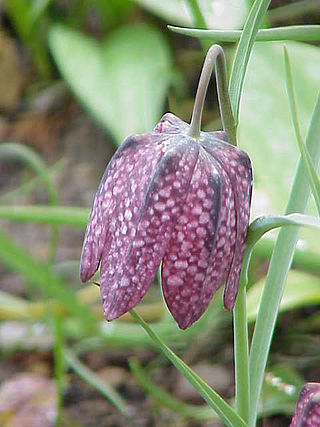
Fritillaria (fritillaries) is a genus of spring flowering herbaceous bulbous perennial plants in the lily family (Liliaceae). The type species, Fritillaria meleagris, was first described in Europe in 1571, while other species from the Middle East and Asia were also introduced to Europe at that time. The genus has about 130–140 species divided among eight subgenera. The flowers are usually solitary, nodding and bell-shaped with bulbs that have fleshy scales, resembling those of lilies. They are known for their large genome size and genetically are very closely related to lilies. They are native to the temperate regions of the Northern hemisphere, from the Mediterranean and North Africa through Eurasia and southwest Asia to western North America. Many are endangered due to enthusiastic picking.

The lily family, Liliaceae, consists of about 15 genera and 610 species of flowering plants within the order Liliales. They are monocotyledonous, perennial, herbaceous, often bulbous geophytes. Plants in this family have evolved with a fair amount of morphological diversity despite genetic similarity. Common characteristics include large flowers with parts arranged in threes: with six colored or patterned petaloid tepals arranged in two whorls, six stamens and a superior ovary. The leaves are linear in shape, with their veins usually arranged parallel to the edges, single and arranged alternating on the stem, or in a rosette at the base. Most species are grown from bulbs, although some have rhizomes. First described in 1789, the lily family became a paraphyletic "catch-all" (wastebasket) group of lilioid monocots that did not fit into other families and included a great number of genera now included in other families and in some cases in other orders. Consequently, many sources and descriptions labelled "Liliaceae" deal with the broader sense of the family.

Fritillaria meleagris is a Eurasian species of flowering plant in the lily family Liliaceae. Its common names include snake's head fritillary, snake's head, chess flower, frog-cup, guinea-hen flower, guinea flower, leper lily, Lazarus bell, chequered lily, chequered daffodil, drooping tulip or, in the British Isles, simply fritillary. The plant is a bulbous perennial native to the flood river plains of Europe where it grows in abundance.

Fritillaria pudica, the yellow fritillary, is a small perennial plant found in the sagebrush country in the western United States and Canada. It is a member of the lily family Liliaceae. Another common name is "yellow bells", since it has a bell-shaped yellow flower. It may be found in dryish, loose soil; it is amongst the first plants to flower after the snow melts, but the flower does not last very long; as the petals age, they turn a brick-red colour and begin to curl outward. The flowers grow singly or in pairs on the stems, and the floral parts grow in multiples of threes. The species produces a small corm, which forms corms earning the genus the nickname 'riceroot'. During his historic journey, Meriwether Lewis collected a specimen while passing through Idaho in 1806.

Fritillaria biflora, the chocolate lily or mission bells, is a species of fritillary native to western California, US, and northern Baja California, Mexico. It occurs in the chaparral and woodlands ecoregion, often in serpentine soil formations and hillside grassland habitats.

Fritillaria camschatcensis is a species of flowering plant native to northeastern Asia and northwestern North America, including northern Oregon, Washington, British Columbia, Alaska, northern Japan, and the Russian Far East. It has many common names, including Kamchatka fritillary and Kamchatka lily.

Fritillaria verticillata is a flowering plant in the lily family Liliaceae, native to Japan, Korea, Mongolia, Xinjiang, Kazakhstan and the Altay region of Siberia.
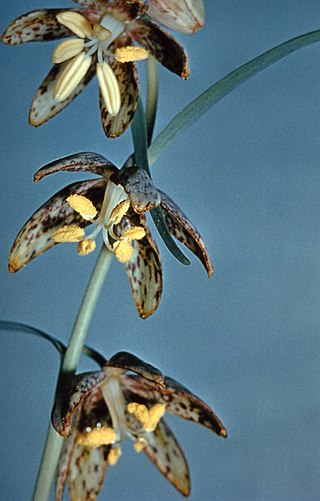
Fritillaria atropurpurea is a species of fritillary known by several common names, including spotted fritillary, purple fritillary, spotted mountainbells, spotted missionbells, and leopard lily.

Fritillaria glauca is a species of fritillary known by the common names Siskiyou fritillary and Siskiyou missionbells.
Fritillaria micrantha, the brown fritillary or brown bells, is a Californian species of flowering plant in the lily family Liliaceae.

Fritillaria striata, the striped adobe lily, is an uncommon species of fritillary.
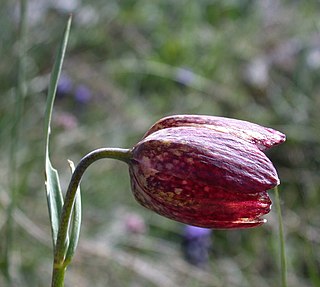
Fritillaria orientalis is a Eurasian species of monocotyledonous plant in the lily family Liliaceae. It was described by Johann Friedrich Adam in 1805, based on specimens collected in Ossetia.
Fritillaria cirrhosa, common name yellow Himalayan fritillary, is an Asian species of herbaceous plant in the lily family, native to China, the Indian Subcontinent, and Myanmar.

Fritillaria tubiformis is a bulbous perennial plant in the lily family Liliaceae, native to Alpine regions of southwestern France and northern Italy.

Fritillaria gussichiae is a European plant species in the lily family Liliaceae, native to Bulgaria, North Macedonia, Serbia, Albania, and Greece.
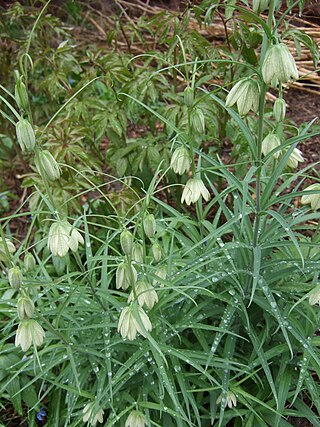
Fritillaria thunbergii is a flowering plant species in the lily family Liliaceae. It is native to Kazakhstan and in Xinjiang Province of western China, though cultivated in other places and naturalized in Japan and in other parts of China.
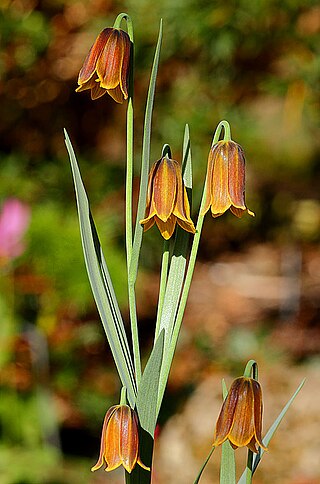
Fritillaria drenovskii is a rare European species of plants in the lily family, native to the Thrace region of northeastern Greece, as well as Blagoevgrad Province in southwestern Bulgaria.

Fritillaria lusitanica is a species of plant in the lily family Liliaceae, endemic to the Iberian Peninsula.
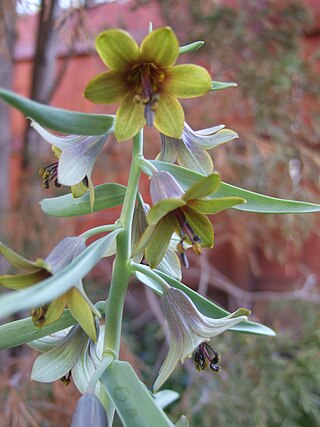
Fritillaria sewerzowii is a perennial herbaceous bulbous plant, distributed in alpine areas of central Asia. It is a species in the genus Fritillaria, in the lily family Liliaceae. It is placed in the subgenus Korolkowia.

















